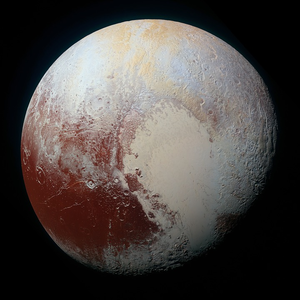Difference between revisions of "Dwarf Planet"
(→About Dwarf Planets) |
|||
| (5 intermediate revisions by 2 users not shown) | |||
| Line 1: | Line 1: | ||
==Key Stage 3== | ==Key Stage 3== | ||
===Meaning=== | ===Meaning=== | ||
| − | A [[Dwarf Planet]] is a large lump of [[rock]] [[Orbit|orbiting]] a [[star]] that has enough [[gravity]] to be | + | A [[Dwarf Planet]] is a large lump of [[rock]] [[Orbit|orbiting]] a [[star]] that has enough [[gravity]] to be round, but not enough to have cleared its [[orbit]] of other [[object]]s. |
===About Dwarf Planets=== | ===About Dwarf Planets=== | ||
| Line 17: | Line 17: | ||
| style="height:20px; width:200px; text-align:center;" |[[Pluto]] is a [[Dwarf Planet]] found beyond the [[orbit]] of [[Neptune]]. | | style="height:20px; width:200px; text-align:center;" |[[Pluto]] is a [[Dwarf Planet]] found beyond the [[orbit]] of [[Neptune]]. | ||
|} | |} | ||
| + | |||
| + | ==Key Stage 4== | ||
| + | ===Meaning=== | ||
| + | A [[Dwarf Planet]] is a large lump of [[rock]] [[Orbit|orbiting]] a [[star]] that has enough [[gravity]] to become a [[sphere]], but not enough to have cleared its [[orbit]] of other [[object]]s. | ||
| + | |||
| + | ===About Dwarf Planets=== | ||
| + | : There are several known [[Dwarf Planet|dwarf planets]] in our [[The Solar System|Solar System]]. However, there may be many other [[Dwarf Planet|dwarf planet]]s that are too far away from [[The Sun]] to be seen. | ||
| + | |||
| + | ===Examples=== | ||
| + | {| class="wikitable" | ||
| + | | style="height:20px; width:200px; text-align:center;" |'''Ceres''' | ||
| + | | style="height:20px; width:200px; text-align:center;" |'''Pluto''' | ||
| + | |- | ||
| + | |[[File:Ceres.png|center|300px]] | ||
| + | |[[File:Pluto.png|center|300px]] | ||
| + | |- | ||
| + | | style="height:20px; width:200px; text-align:center;" |[[Ceres]] is a [[Dwarf Planet]] found in the [[Asteroid Belt]]. | ||
| + | | style="height:20px; width:200px; text-align:center;" |[[Pluto]] is a [[Dwarf Planet]] found beyond the [[orbit]] of [[Neptune]]. | ||
| + | |} | ||
| + | |||
| + | |||
| + | ===References=== | ||
| + | ====AQA==== | ||
| + | |||
| + | :[https://www.amazon.co.uk/gp/product/0008158770/ref=as_li_tl?ie=UTF8&camp=1634&creative=6738&creativeASIN=0008158770&linkCode=as2&tag=nrjc-21&linkId=ec31595e720e1529e49876c3866fff6e ''Dwarf planet, pages 275, 277, GCSE Physics; Student Book, Collins, AQA ''] | ||
| + | :[https://www.amazon.co.uk/gp/product/178294558X/ref=as_li_tl?ie=UTF8&camp=1634&creative=6738&creativeASIN=178294558X&linkCode=as2&tag=nrjc-21&linkId=f0dfb66dafcb0c6e9449e7b1a4ae1ac98 ''Dwarf planets, page 101, GCSE Physics; The Revision Guide, CGP, AQA ''] | ||
| + | :[https://www.amazon.co.uk/gp/product/1471851370/ref=as_li_tl?ie=UTF8&camp=1634&creative=6738&creativeASIN=1471851370&linkCode=as2&tag=nrjc-21&linkId=01c69b0ae058f809cf636033e6ba793e ''Dwarf planets, page 249, GCSE Physics, Hodder, AQA ''] | ||
| + | :[https://www.amazon.co.uk/gp/product/1782945970/ref=as_li_tl?ie=UTF8&camp=1634&creative=6738&creativeASIN=1782945970&linkCode=as2&tag=nrjc-21&linkId=a120d24dcc7cc7a58192069a3aafc1d2 ''Dwarf planets, page 320, GCSE Physics; The Complete 9-1 Course for AQA, CGP, AQA ''] | ||
| + | |||
| + | ====Edexcel==== | ||
| + | |||
| + | :[https://www.amazon.co.uk/gp/product/1292120223/ref=as_li_tl?ie=UTF8&camp=1634&creative=6738&creativeASIN=1292120223&linkCode=as2&tag=nrjc-21&linkId=068ecf40278c32406a7f1c6e66751417 ''Dwarf planets, page 118, GCSE Physics, Pearson Edexcel ''] | ||
| + | :[https://www.amazon.co.uk/gp/product/1782948163/ref=as_li_tl?ie=UTF8&camp=1634&creative=6738&creativeASIN=1782948163&linkCode=as2&tag=nrjc-21&linkId=0fdbfd5dd397d6e24a9dfb250f08587f ''Dwarf planets, page 184, GCSE Physics, CGP, Edexcel ''] | ||
Latest revision as of 20:51, 17 November 2019
Contents
Key Stage 3
Meaning
A Dwarf Planet is a large lump of rock orbiting a star that has enough gravity to be round, but not enough to have cleared its orbit of other objects.
About Dwarf Planets
- There are several known dwarf planets in our Solar System. However, there may be many other dwarf planets that are too far away from The Sun to be seen.
Examples
| Ceres | Pluto |
| Ceres is a Dwarf Planet found in the Asteroid Belt. | Pluto is a Dwarf Planet found beyond the orbit of Neptune. |
Key Stage 4
Meaning
A Dwarf Planet is a large lump of rock orbiting a star that has enough gravity to become a sphere, but not enough to have cleared its orbit of other objects.
About Dwarf Planets
- There are several known dwarf planets in our Solar System. However, there may be many other dwarf planets that are too far away from The Sun to be seen.
Examples
| Ceres | Pluto |
| Ceres is a Dwarf Planet found in the Asteroid Belt. | Pluto is a Dwarf Planet found beyond the orbit of Neptune. |
References
AQA
- Dwarf planet, pages 275, 277, GCSE Physics; Student Book, Collins, AQA
- Dwarf planets, page 101, GCSE Physics; The Revision Guide, CGP, AQA
- Dwarf planets, page 249, GCSE Physics, Hodder, AQA
- Dwarf planets, page 320, GCSE Physics; The Complete 9-1 Course for AQA, CGP, AQA

